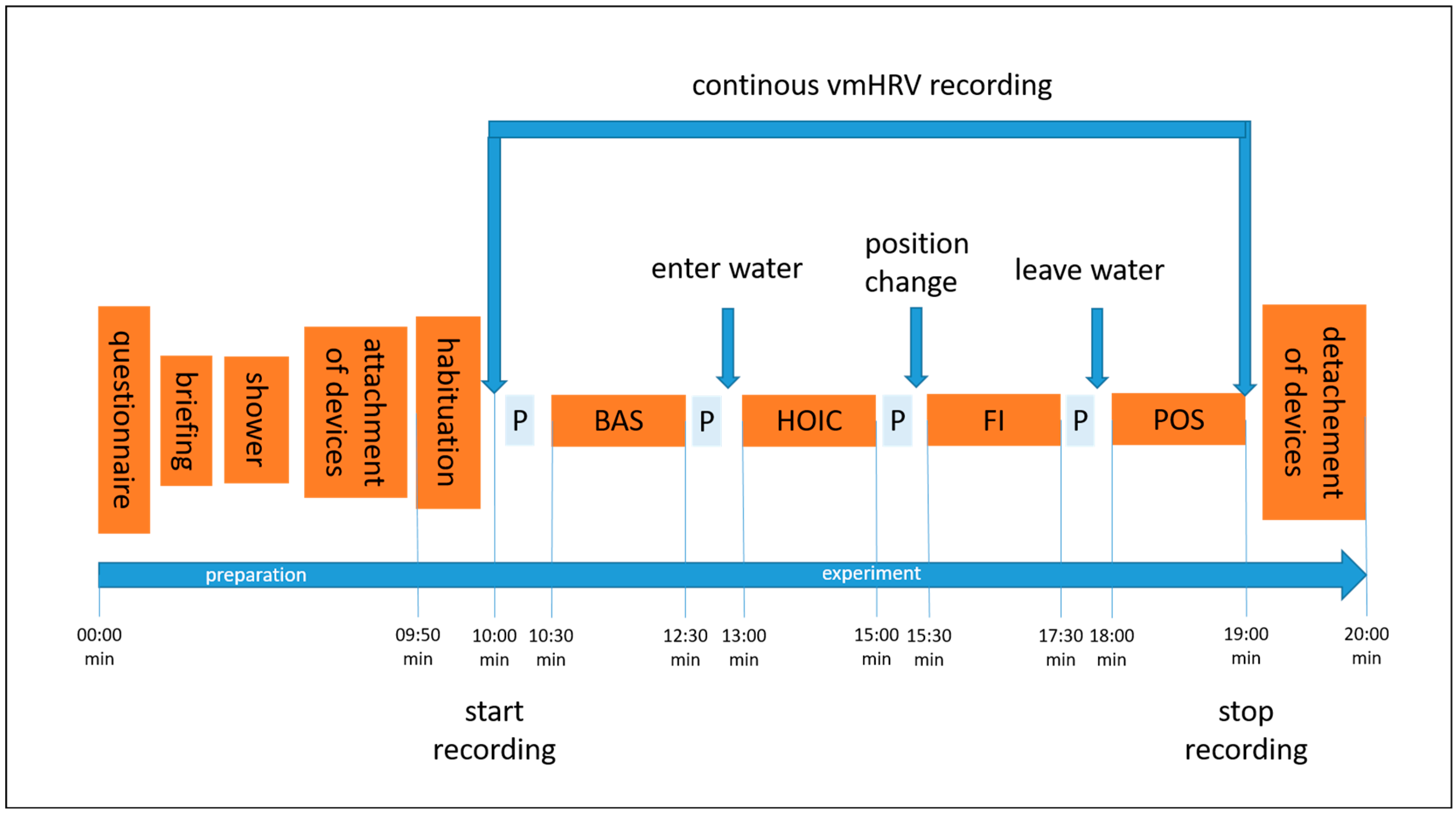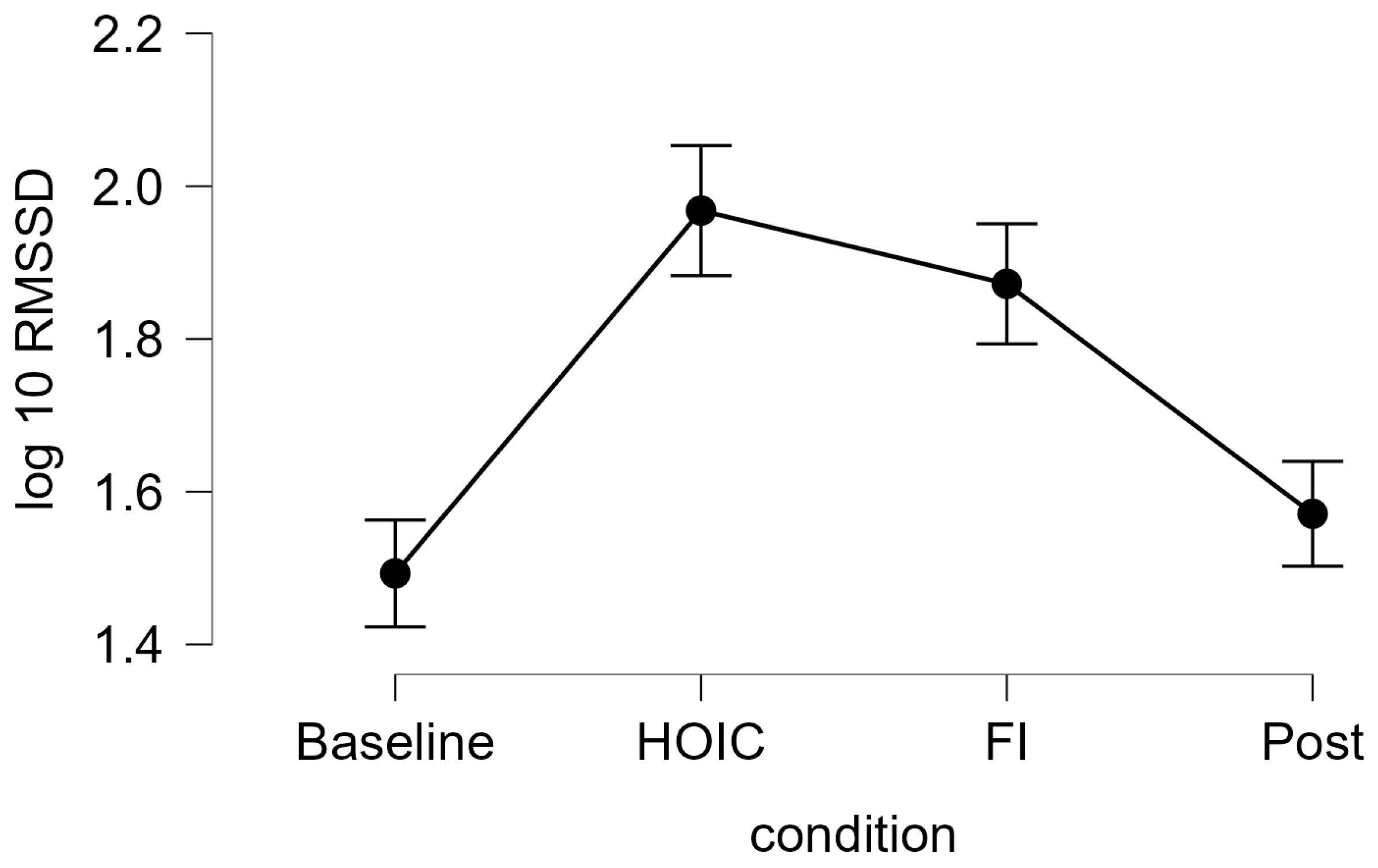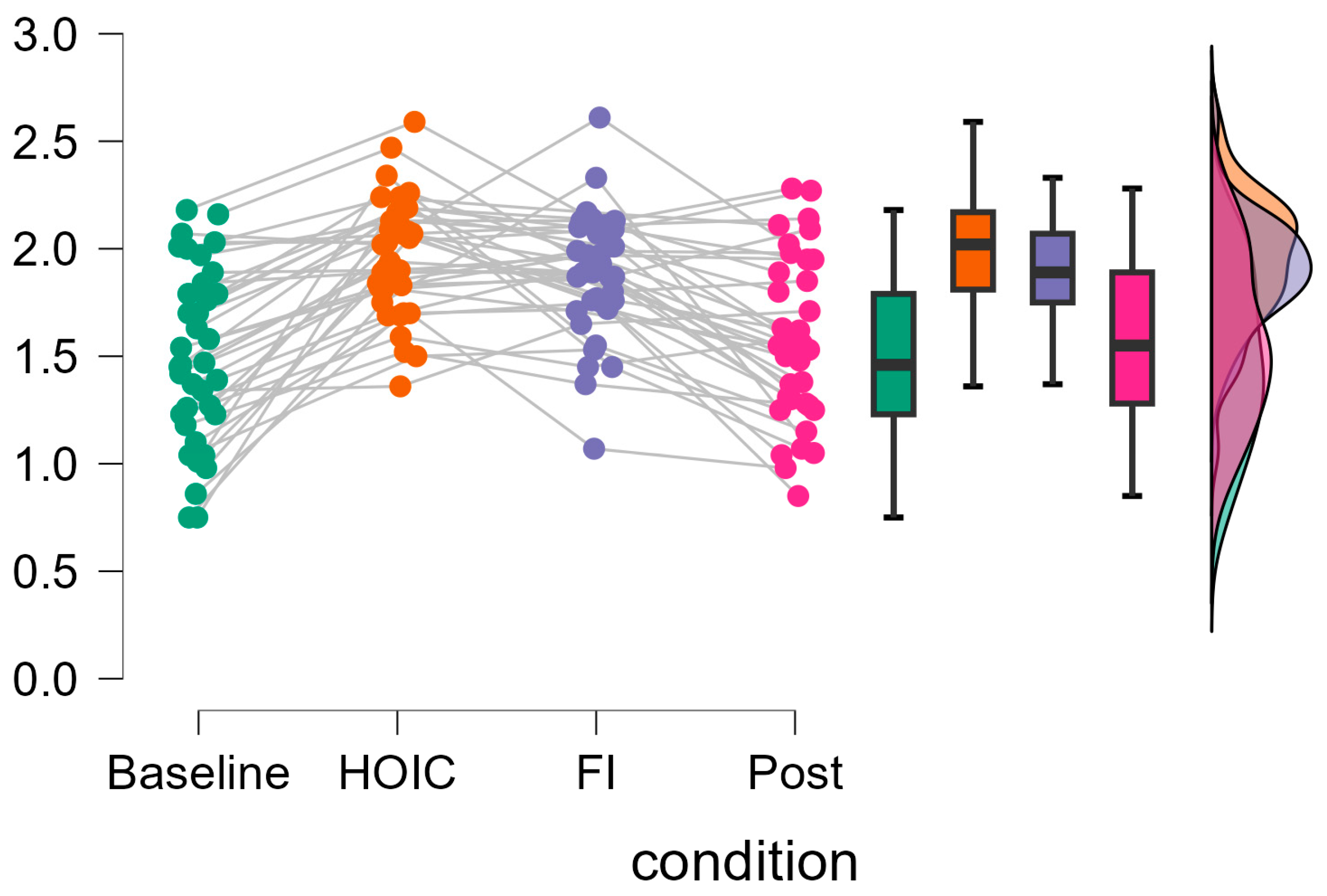Effects of Adding Facial Immersion to Chest-Level Water Immersion on Vagally-Mediated Heart Rate Variability
Abstract
1. Introduction
- HOIC increases RMSSD compared to baseline;
- Additional facial immersion elicits higher RMSSD values compared to HOIC alone;
- RMSSD returns to baseline post measures once all stimuli are removed.
2. Materials and Methods
2.1. Participants
2.2. Measures
2.2.1. Questionnaire
2.2.2. HRV Measurement
2.3. Procedure
2.4. Data Analysis
3. Results
4. Discussion
5. Conclusions
Author Contributions
Funding
Institutional Review Board Statement
Informed Consent Statement
Data Availability Statement
Acknowledgments
Conflicts of Interest
Abbreviations
| HOIC | Head-out water immersion up to the chest |
| vmHRV | Vagally mediated heart rate variability |
| RMSSD | Root mean square of successive differences |
| RRI | RR intervals |
References
- Laborde, S.; Mosley, E.; Thayer, J.F. Heart Rate Variability and Cardiac Vagal Tone in Psychophysiological Research—Recommendations for Experiment Planning, Data Analysis, and Data Reporting. Front. Psychol. 2017, 8, 213. [Google Scholar] [CrossRef]
- Baumeister-Lingens, L.; Rothe, R.; Wolff, L.; Gerlach, A.L.; Koenig, J.; Sigrist, C. Vagally-Mediated Heart Rate Variability and Depression in Children and Adolescents—A Meta-Analytic Update. J. Affect. Disord. 2023, 339, 237–255. [Google Scholar] [CrossRef] [PubMed]
- Kemp, A.H.; Quintana, D.S.; Gray, M.A.; Felmingham, K.L.; Brown, K.; Gatt, J.M. Impact of Depression and Antidepressant Treatment on Heart Rate Variability: A Review and Meta-Analysis. Biol. Psychiatry 2010, 67, 1067–1074. [Google Scholar] [CrossRef]
- Berntson, G.G.; Bigger, J.T.; Eckberg, D.L.; Grossman, P.; Kaufmann, P.G.; Malik, M.; Nagaraja, H.N.; Porges, S.W.; Saul, J.P.; Stone, P.H.; et al. Heart Rate Variability: Origins, Methods, and Interpretive Caveats. Psychophysiology 1997, 34, 623–648. [Google Scholar] [CrossRef] [PubMed]
- Kleiger, R.E.; Stein, P.K.; Bigger, J.T. Heart Rate Variability: Measurement and Clinical Utility. Ann. Noninvasive Electrocardiol. 2005, 10, 88–101. [Google Scholar] [CrossRef]
- Thayer, J.F.; Hansen, A.L.; Saus-Rose, E.; Johnsen, B.H. Heart Rate Variability, Prefrontal Neural Function, and Cognitive Performance: The Neurovisceral Integration Perspective on Self-Regulation, Adaptation, and Health. Ann. Behav. Med. 2009, 37, 141–153. [Google Scholar] [CrossRef] [PubMed]
- Thayer, J.F.; Ahs, F.; Fredrikson, M.; Sollers, J.J.; Wager, T.D. A Meta-Analysis of Heart Rate Variability and Neuroimaging Studies: Implications for Heart Rate Variability as a Marker of Stress and Health. Neurosci. Biobehav. Rev. 2012, 36, 747–756. [Google Scholar] [CrossRef] [PubMed]
- Laborde, S.; Mosley, E.; Mertgen, A. Vagal Tank Theory: The Three Rs of Cardiac Vagal Control Functioning—Resting, Reactivity, and Recovery. Front. Neurosci. 2018, 12, 458. [Google Scholar] [CrossRef]
- Wilcock, I.M.; Cronin, J.B.; Hing, W.A. Physiological Response to Water Immersion. Sports Med. 2006, 36, 747–765. [Google Scholar] [CrossRef]
- Shiraishi, M.; Schou, M.; Gybel, M.; Christensen, N.J.; Norsk, P. Comparison of Acute Cardiovascular Responses to Water Immersion and Head-down Tilt in Humans. J. Appl. Physiol. 2002, 92, 264–268. [Google Scholar] [CrossRef]
- Kollai, M.; Jokkel, G.; Bonyhay, I.; Tomcsanyi, J.; Naszlady, A. Relation between Baroreflex Sensitivity and Cardiac Vagal Tone in Humans. Am. J. Physiol.-Heart Circ. Physiol. 1994, 266, H21–H27. [Google Scholar] [CrossRef]
- Shaffer, F.; Meehan, Z.M. A Practical Guide to Resonance Frequency Assessment for Heart Rate Variability Biofeedback. Front. Neurosci. 2020, 14, 570400. [Google Scholar]
- Shaffer, F.; McCraty, R.; Zerr, C.L. A Healthy Heart Is Not a Metronome: An Integrative Review of the Heart’s Anatomy and Heart Rate Variability. Front. Psychol. 2014, 5, 1040. [Google Scholar] [CrossRef]
- Ackermann, S.P.; Raab, M.; Backschat, S.; Smith, D.J.C.; Javelle, F.; Laborde, S. The Diving Response and Cardiac Vagal Activity: A Systematic Review and Meta-Analysis. Psychophysiology 2023, 60, e14183. [Google Scholar] [CrossRef]
- Buchholz, B.; Kelly, J.; Bernatene, E.A.; Méndez Diodati, N.; Gelpi, R.J. Antagonistic and Synergistic Activation of Cardiovascular Vagal and Sympathetic Motor Outflows in Trigeminal Reflexes. Front. Neurol. 2017, 8, 52. [Google Scholar] [CrossRef] [PubMed]
- de Bruijn, R.; Richardson, M.; Schagatay, E. Oxygen-Conserving Effect of the Diving Response in the Immersed Human. Diving Hyperb. Med. J. South. Pac. Underw. Med. Soc. 2009, 39, 193–199. [Google Scholar]
- Foster, G.E.; Sheel, A.W. The Human Diving Response, Its Function, and Its Control. Scand. J. Med. Sci. Sports 2005, 15, 3–12. [Google Scholar] [CrossRef] [PubMed]
- McCulloch, P.F.; Lahrman, K.A.; DelPrete, B.; DiNovo, K.M. Innervation of the Nose and Nasal Region of the Rat: Implications for Initiating the Mammalian Diving Response. Front. Neuroanat. 2018, 12, 85. [Google Scholar] [CrossRef] [PubMed]
- Schaller, B.; Cornelius, J.F.; Prabhakar, H.; Koerbel, A.; Gnanalingham, K.; Sandu, N.; Ottaviani, G.; Filis, A.; Buchfelder, M.; Trigemino-Cardiac Reflex Examination Group (TCREG). The Trigemino-Cardiac Reflex: An Update of the Current Knowledge. J. Neurosurg. Anesthesiol. 2009, 21, 187–195. [Google Scholar] [CrossRef]
- Moore, T.; Lin, Y.-C.; Lally, D.; Hong, S. Effects of Temperature, Immersion, and Ambient Pressure on Human Apneic Bradycardia. J. Appl. Physiol. 1972, 33, 36–41. [Google Scholar] [CrossRef] [PubMed]
- Schipke, J.D.; Pelzer, M. Effect of Immersion, Submersion, and Scuba Diving on Heart Rate Variability. Br. Sports Med. 2001, 35, 174–180. [Google Scholar] [CrossRef] [PubMed]
- Kinoshita, T.; Nagata, S.; Baba, R.; Kohmoto, T.; Iwagaki, S. Cold-Water Face Immersion Per Se Elicits Cardiac Parasympathetic Activity. Circ. J. 2006, 70, 773–776. [Google Scholar] [CrossRef] [PubMed]
- Mosley, E.; Laborde, S. A Scoping Review of Heart Rate Variability in Sport and Exercise Psychology. Int. Rev. Sport. Exerc. Psychol. 2022, 17, 773–847. [Google Scholar] [CrossRef]
- Faul, F.; Erdfelder, E.; Buchner, A.; Lang, A.-G. Statistical Power Analyses Using G*Power 3.1: Tests for Correlation and Regression Analyses. Behav. Res. Methods 2009, 41, 1149–1160. [Google Scholar] [CrossRef] [PubMed]
- McKay, A.K.A.; Stellingwerff, T.; Smith, E.S.; Martin, D.T.; Mujika, I.; Goosey-Tolfrey, V.L.; Sheppard, J.; Burke, L.M. Defining Training and Performance Caliber: A Participant Classification Framework. Int. J. Sports Physiol. Perform. 2022, 17, 317–331. [Google Scholar] [CrossRef]
- Alvares, G.A.; Quintana, D.S.; Hickie, I.B.; Guastella, A.J. Autonomic Nervous System Dysfunction in Psychiatric Disorders and the Impact of Psychotropic Medications: A Systematic Review and Meta-Analysis. J. Psychiatry Neurosci. 2016, 41, 89–104. [Google Scholar] [CrossRef]
- Lu, C.L.; Zou, X.; Orr, W.C.; Chen, J.D. Postprandial Changes of Sympathovagal Balance Measured by Heart Rate Variability. Dig. Dis. Sci. 1999, 44, 857–861. [Google Scholar] [CrossRef] [PubMed]
- Inoue, N.; Kuroda, K.; Sugimoto, A.; Kakuda, T.; Fushiki, T. Autonomic Nervous Responses According to Preference for the Odor of Jasmine Tea. Biosci. Biotechnol. Biochem. 2003, 67, 1206–1214. [Google Scholar] [CrossRef] [PubMed]
- Zimmermann-Viehoff, F.; Thayer, J.; Koenig, J.; Herrmann, C.; Weber, C.S.; Deter, H.-C. Short-Term Effects of Espresso Coffee on Heart Rate Variability and Blood Pressure in Habitual and Non-Habitual Coffee Consumers—A Randomized Crossover Study. Nutr. Neurosci. 2016, 19, 169–175. [Google Scholar] [CrossRef] [PubMed]
- Sjoberg, N.; Saint, D.A. A Single 4 Mg Dose of Nicotine Decreases Heart Rate Variability in Healthy Nonsmokers: Implications for Smoking Cessation Programs. Nicotine Tob. Res. 2011, 13, 369–372. [Google Scholar] [CrossRef]
- Stanley, J.; Peake, J.M.; Buchheit, M. Cardiac Parasympathetic Reactivation Following Exercise: Implications for Training Prescription. Sports Med. 2013, 43, 1259–1277. [Google Scholar] [CrossRef] [PubMed]
- Quintana, D.S.; McGregor, I.S.; Guastella, A.J.; Malhi, G.S.; Kemp, A.H. A Meta-Analysis on the Impact of Alcohol Dependence on Short-Term Resting-State Heart Rate Variability: Implications for Cardiovascular Risk. Alcohol. Clin. Exp. Res. 2013, 37, E23–E29. [Google Scholar] [CrossRef] [PubMed]
- Nisenbaum, M.G.; de Melo, N.R.; Giribela, C.R.G.; de Morais, T.L.; Guerra, G.M.; de Angelis, K.; Mostarda, C.; Baracat, E.C.; Consolim-Colombo, F.M. Effects of a Contraceptive Containing Drospirenone and Ethinyl Estradiol on Blood Pressure and Autonomic Tone: A Prospective Controlled Clinical Trial. Eur. J. Obstet. Gynecol. Reprod. Biol. 2014, 175, 62–66. [Google Scholar] [CrossRef]
- Weippert, M.; Kumar, M.; Kreuzfeld, S.; Arndt, D.; Rieger, A.; Stoll, R. Comparison of Three Mobile Devices for Measuring R–R Intervals and Heart Rate Variability: Polar S810i, Suunto T6 and an Ambulatory ECG System. Eur. J. Appl. Physiol. 2010, 109, 779–786. [Google Scholar] [CrossRef] [PubMed]
- Schaffarczyk, M.; Rogers, B.; Reer, R.; Gronwald, T. Validity of the Polar H10 Sensor for Heart Rate Variability Analysis during Resting State and Incremental Exercise in Recreational Men and Women. Sensors 2022, 22, 6536. [Google Scholar] [CrossRef] [PubMed]
- Giles, D.; Draper, N.; Neil, W. Validity of the Polar V800 Heart Rate Monitor to Measure RR Intervals at Rest. Eur. J. Appl. Physiol. 2016, 116, 563–571. [Google Scholar] [CrossRef]
- Polar Misst Der H10 Die Herzfrequenz Beim Schwimmen?|Polar Deutschland. Available online: https://support.polar.com/de/support/does_h10_measure_heart_rate_when_swimming?product_id=89505&category=swimming (accessed on 9 July 2023).
- Massin, M.M.; Maeyns, K.; Withofs, N.; Ravet, F.; Gérard, P. Circadian Rhythm of Heart Rate and Heart Rate Variability. Arch. Dis. Child. 2000, 83, 179–182. [Google Scholar] [CrossRef] [PubMed]
- van Eekelen, A.P.J.; Houtveen, J.H.; Kerkhof, G.A. Circadian Variation in Cardiac Autonomic Activity: Reactivity Measurements to Different Types of Stressors. Chronobiol. Int. 2004, 21, 107–129. [Google Scholar] [CrossRef] [PubMed]
- Marées, H.d.S.; Heck, H.; Bartmus, U. (Eds.) Korrigierter Nachdruck der 9; vollständig überarbeiteten und erweiterten Auflage; Sportverlag Strauß: Hellenthal, Germany, 2017; ISBN 978-3-86884-100-8. [Google Scholar]
- Berntson, G.G.; Stowell, J.R. ECG Artifacts and Heart Period Variability: Don’t Miss a Beat! Psychophysiology 1998, 35, 127–132. [Google Scholar] [CrossRef]
- Yagin, F.H.; Pinar, A.; Santos de Sousa Fernandes, M. Statistical Effect Sizes in Sports Science. J. Exerc. Sci. Phys. Act. Rev. 2024, 2, 164–171. [Google Scholar] [CrossRef]
- Farhi, L.E.; Linnarsson, D. Cardiopulmonary Readjustments during Graded Immersion in Water at 35 °C. Respir. Physiol. 1977, 30, 35–50. [Google Scholar] [CrossRef] [PubMed]
- Srámek, P.; Simecková, M.; Janský, L.; Savlíková, J.; Vybíral, S. Human Physiological Responses to Immersion into Water of Different Temperatures. Eur. J. Appl. Physiol. 2000, 81, 436–442. [Google Scholar] [CrossRef] [PubMed]
- Roskamm, H.; Allgeier, J.; Hofmann, M. Herzkrankheiten: Pathophysiologie, Diagnostik, Therapie; Mit 138 Tabellen; 5., vollst. überarb. und aktualisierte Aufl.; Springer: Berlin/Heidelberg, Germany, 2004; ISBN 978-3-540-40149-0. [Google Scholar]
- Löllgen, H.; von Nieding, G.; Koppenhagen, K.; Kersting, F.; Just, H. Hemodynamic Response to Graded Water Immersion. Klin. Wochenschr. 1981, 59, 623–628. [Google Scholar] [CrossRef]
- Brandes, R.; Lang, F.; Schmidt, R.F. Physiologie des Menschen: Mit Pathophysiologie; Lehrbuch; 32. Auflage.; Springer: Berlin, Germany, 2020; ISBN 978-3-662-56467-7. [Google Scholar]
- Gabrielsen, A.; Videbaek, R.; Johansen, L.B.; Warberg, J.; Christensen, N.J.; Pump, B.; Norsk, P. Forearm Vascular and Neuroendocrine Responses to Graded Water Immersion in Humans. Acta Physiol. Scand. 2000, 169, 87–94. [Google Scholar] [CrossRef]
- Pump, B.; Shiraishi, M.; Gabrielsen, A.; Bie, P.; Christensen, N.J.; Norsk, P. Cardiovascular Effects of Static Carotid Baroreceptor Stimulation during Water Immersion in Humans. Am. J. Physiol. Heart Circ. Physiol. 2001, 280, H2607–H2615. [Google Scholar] [CrossRef]
- Parker, R.; Higgins, Z.; Mlombile, Z.N.P.; Mohr, M.J.; Wagner, T.L. The Effects of Warm Water Immersion on Blood Pressure, Heart Rate and Heart Rate Variability in People with Chronic Fatigue Syndrome. S. Afr. J. Physiother. 2018, 74, 442. [Google Scholar] [CrossRef] [PubMed]
- Panneton, W.M.; Gan, Q. The Mammalian Diving Response: Inroads to Its Neural Control. Front. Neurosci. 2020, 14, 524. [Google Scholar] [CrossRef]
- Powell, K.; Lin, K.; Tambo, W.; Saavedra, A.P.; Sciubba, D.; Al Abed, Y.; Li, C. Trigeminal Nerve Stimulation: A Current State-of-the-Art Review. Bioelectron. Med. 2023, 9, 30. [Google Scholar] [CrossRef]
- Costalat, G.; Pichon, A.; Joulia, F.; Lemaître, F. Modeling the Diving Bradycardia: Toward an “Oxygen-Conserving Breaking Point”? Eur. J. Appl. Physiol. 2015, 115, 1475–1484. [Google Scholar] [CrossRef]
- Edelhäuser, F.; Goebel, S.; Scheffer, C.; Cysarz, D. P02.181. Heart Rate Variability and Peripheral Temperature during Whole Body Immersion at Different Water Temperatures. BMC Complement. Altern. Med. 2012, 12, P237. [Google Scholar] [CrossRef]
- Mischkowski, D.; Palacios-Barrios, E.E.; Banker, L.; Dildine, T.C.; Atlas, L.Y. Pain or Nociception? Subjective Experience Mediates the Effects of Acute Noxious Heat on Autonomic Responses—Corrected and Republished. Pain 2019, 160, 1469–1481. [Google Scholar] [CrossRef]
- Quintana, D.S.; Heathers, J.A.J. Considerations in the Assessment of Heart Rate Variability in Biobehavioral Research. Front. Psychol. 2014, 5, 805. [Google Scholar] [CrossRef]
- Speakman, J.R. Obesity and Thermoregulation. Handb. Clin. Neurol. 2018, 156, 431–443. [Google Scholar] [CrossRef] [PubMed]




| Height (m) | Weight (kg) | Age (Years) | Sleep (Hours) | BMI | ||||||
|---|---|---|---|---|---|---|---|---|---|---|
| Male | Female | Male | Female | Male | Female | Male | Female | Male | Female | |
| M | 1.81 | 1.69 | 76.6 | 62.7 | 25.1 | 22.5 | 6.8 | 6.9 | 23.22 | 21.93 |
| SD | 0.09 | 0.08 | 12.1 | 5.3 | 5.1 | 2.2 | 0.8 | 1.0 | 2.23 | 1.72 |
| Log10 BAS | Log10 HOIC | Log10 FI | Log10 Post | |||||
|---|---|---|---|---|---|---|---|---|
| Gender | Male | Female | Male | Female | Male | Female | Male | Female |
| M | 1.57 | 1.36 | 1.99 | 1.94 | 1.94 | 1.76 | 1.60 | 1.53 |
| SD | 0.42 | 0.36 | 0.27 | 0.29 | 0.26 | 0.30 | 0.38 | 0.39 |
| BAS | HOIC | FI | Post | |||||
|---|---|---|---|---|---|---|---|---|
| Gender | Male | Female | Male | Female | Male | Female | Male | Female |
| M | 73.26 | 92.77 | 61.51 | 73.00 | 59.435 | 74.40 | 71.36 | 86.43 |
| SD | 12.70 | 18.94 | 9.65 | 12.09 | 9.54 | 14.61 | 13.21 | 15.80 |
Disclaimer/Publisher’s Note: The statements, opinions and data contained in all publications are solely those of the individual author(s) and contributor(s) and not of MDPI and/or the editor(s). MDPI and/or the editor(s) disclaim responsibility for any injury to people or property resulting from any ideas, methods, instructions or products referred to in the content. |
© 2025 by the authors. Licensee MDPI, Basel, Switzerland. This article is an open access article distributed under the terms and conditions of the Creative Commons Attribution (CC BY) license (https://creativecommons.org/licenses/by/4.0/).
Share and Cite
Baus, T.L.; Ackermann, S.P.; Laborde, S. Effects of Adding Facial Immersion to Chest-Level Water Immersion on Vagally-Mediated Heart Rate Variability. Sports 2025, 13, 64. https://doi.org/10.3390/sports13030064
Baus TL, Ackermann SP, Laborde S. Effects of Adding Facial Immersion to Chest-Level Water Immersion on Vagally-Mediated Heart Rate Variability. Sports. 2025; 13(3):64. https://doi.org/10.3390/sports13030064
Chicago/Turabian StyleBaus, Tina L., Stefan P. Ackermann, and Sylvain Laborde. 2025. "Effects of Adding Facial Immersion to Chest-Level Water Immersion on Vagally-Mediated Heart Rate Variability" Sports 13, no. 3: 64. https://doi.org/10.3390/sports13030064
APA StyleBaus, T. L., Ackermann, S. P., & Laborde, S. (2025). Effects of Adding Facial Immersion to Chest-Level Water Immersion on Vagally-Mediated Heart Rate Variability. Sports, 13(3), 64. https://doi.org/10.3390/sports13030064








